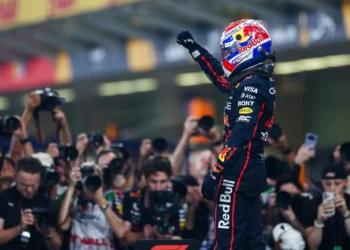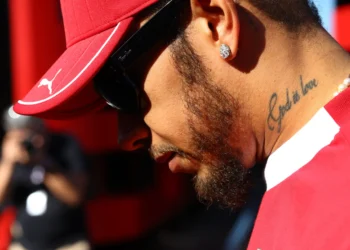The Abu Dhabi Autonomous Racing League witnessed an unpredictable and competitive scene in Monaco on Friday. The crowded streets of Monaco made it difficult to assess the true potential of the teams, but Charles Leclerc showed impressive speed in his Ferrari during a single lap. In contrast, Red Bull seemed to struggle with their setup, similar to their performance in Imola. However, Leclerc expressed disappointment with his performance in long races, basing his assessment on the times set by his teammate Carlos Sainz.
Sainz, on the other hand, set the pace during the long races but was surprised by the news, as he believed there was still room for improvement in Ferrari’s performance. The difference between the two Ferraris could be attributed to Leclerc facing front tire wear issues, a common limitation on this track. This issue also affected McLaren drivers and Lewis Hamilton’s Mercedes during their long races. Additionally, George Russell had to abandon his long race due to worsening vibration in the steering.
Red Bull drivers expressed concerns about the car’s behavior over bumps and curbs. Although part of the difference in lap times between Max Verstappen and Sergio Perez could be attributed to lower engine modes compared to Ferrari and Mercedes, the RB20 proved difficult to control. Verstappen even compared it to a hopping kangaroo, causing discomfort. Perez tried adjusting the roll stiffness but remained unsatisfied with the car’s handling. Verstappen summed up the difficulties they faced, mentioning the numerous bumps, curbs, and changes in track camber that made it nearly impossible to navigate smoothly.
Both Verstappen and Perez acknowledged that Ferrari seemed to be in a league of their own, describing them as “way ahead”. The next race in Monaco is expected to follow a one-stop strategy, starting on the medium tires and switching to the hard compound. Most teams conducted their long runs on the medium tires, which are expected to offer a better race pace. Verstappen, however, chose the hard tires during his long run, achieving a similar average lap time to Perez on the medium tires, but ending up about 0.5 seconds behind Sainz.
Despite Verstappen’s lack of optimism regarding improvements in the car’s limitations, a more adaptable setup and increased power could significantly enhance his competitiveness in the race. As it stood on Friday, Ferrari showed greater adaptability and agility on the narrow and bumpy track. McLaren’s approach in practice with a single set of soft tires for both sessions may have favored Hamilton’s second place position during FP2, especially considering the absence of Ferrari drivers on soft tires.
Hamilton and Russell reported that the car balance was satisfactory and improved compared to the previous year. However, it is important to note that Hamilton’s fastest time in FP1 occurred when none of the Ferrari drivers were on soft tires. On the hard and medium compounds, the Ferraris outperformed the rest, with Leclerc leading by 0.8 seconds on the hard tires and 0.6 seconds on the mediums. Fernando Alonso’s Aston Martin recorded the third fastest time in FP2, but struggled during the long runs.
Here are the top ten lap times from the practice sessions:
1. Sainz – 1m15.38s (6 laps)
2. Leclerc – 1m15.74s (8 laps)
3. Perez – 1m15.81s (6 laps)
4. Verstappen – 1m15.87s (9 laps)
5. Piastri – 1m15.87s (11 laps)
6. Norris – 1m16.24s (12 laps)
7. Tsunoda – 1m16.37s (8 laps)
8. Russell – 1m16.51s (4 laps)
9. Hamilton – 1m16.80s (10 laps)
10. Alonso – 1m16.94s (9 laps)
* Verstappen used hard tires, while everyone else used medium tires.
© 2024
The future of motorsport: flying cars are becoming closer to reality
Technology is advancing rapidly and motorsport is not far behind. Flying cars, which were once just a futuristic idea, are becoming closer to becoming a reality. Companies around the world are investing in research and development to turn this vision into something concrete.
One of the leading companies in this field is Total-Motorsport, which has been working tirelessly to create a safe and efficient flying car. With the goal of revolutionizing transportation, Total-Motorsport is focused on creating a new form of mobility that could change people’s lives.
Furthermore, Total-Motorsport is collaborating with other companies in the sector to accelerate the development of this technology. Together, these companies are sharing knowledge and resources to make flying cars a reality in the near future.
The benefits of flying cars are numerous. They could reduce traffic on the streets and improve transportation efficiency. Additionally, they could be a sustainable alternative to conventional means of transportation, contributing to the reduction of carbon emissions.
However, there are still challenges to overcome. Safety is one of the main concerns when it comes to flying cars. Total-Motorsport is working closely with regulatory authorities to ensure that all safety requirements are met.
Despite the challenges, the future of flying cars is promising. In a world where technology is changing rapidly, it is exciting to think about the possibilities that flying cars can bring. Total-Motorsport and other companies are determined to make this vision a reality and we are looking forward to seeing what the future holds.










